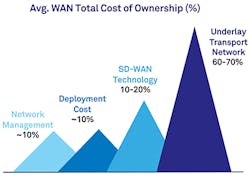Guiding Clients as They Upgrade Their Legacy WAN
Help Your Clients Find the Right Legacy Network Upgrade Strategy
As your enterprise clients prepare for their future successes, they should look to the past when it comes to their legacy network infrastructure.
Organizations are scrambling to adopt ambitious new technology initiatives related to cloud computing, IoT, artificial intelligence, 5G, or unified communications—all to remain relevant and retain top talent in today’s hyper-competitive environment.
Network user behavior is also changing. Gone are the days of everyone logging on only at the office at the same times. Today, demands on a network occur at different times from different regions making scalable network optimization a priority.
However, one commonly overlooked resource is the fundamental infrastructure necessary to achieve most business objectives: a reliable, stable, and scalable, network. Without upgrading, or at least maintaining, legacy network infrastructures, your clients may face outages, latency, faulty performance, and low customer adoption.
While many companies realize the need to move on from their legacy wide area network (WAN) infrastructure, common barriers include cost, resources and administrative logistics. However, there are bright spots in the form of new software-based networking technologies more suited to the adaptive networking needs of today’s flexible and agile business environments.
The WAN Evolution
The most common infrastructure in place is some flavor of WAN. These types of networks use dedicated private links and include such technologies as Multi-protocol Label Switching (MPLS). A WAN-MPLS model, for example, is based on physical network connections among centralized data hubs, data centers, and sites.
Legacy networks are often contracted through a service provider like you—with set terms based on bandwidth or number of sites.
And while your customers are YOURS right now, don’t assume that will always be the case. Keeping them for the long-term requires that you become their consultative partner, looking out for their future after you fully understand their past. You can do that by helping them see both the pros and cons of their legacy network and the benefits/pitfalls of the future strategy they’re considering.
Education Is Transformative
They may be realizing their lofty goals to build-out a whole new network and team to manage it and maintain it requires significant changes in skills and resources. They may not realize that the new network approach could take fewer people, but also has the potential to create conflicts of interest as they end up fighting their own internal headwinds.
The bottom line is this: switching equipment and vendors can also be costly battles.
In today’s high-pressure, always-on environments, companies need constant network status updates, which are often difficult to obtain with a WAN-based model. Plus, legacy WAN technology can be expensive to maintain. Upgrading is often marketed as a cost saving. However, a company usually won’t see any of that return until much later from a total cost of ownership perspective.
As you guide your clients, explaining that cost is only one factor to consider when planning a network upgrade. Among the many key elements, they should look for in a new network are security, flexibility, and performance.
Share why the option for Software-Defined Wide Area Networking (SD-WAN) has emerged as an attractive solution for provisioning and optimizing distributed IT networks. Quite simply, SD-WAN uses the Internet to send traffic between networks, controlled by centralized software, or to provision new networks at the edge. This coincides with the trend of more organizations moving to cloud-based models and becoming less reliant on data centers.
You can also cite research that shares how more enterprises are realizing the benefits of SD-WAN. According to the TeleGeography SD-WAN Research Service, the number of enterprises they surveyed deploying SD-WAN increased from 18% in 2018 to 43% of respondents in 2020.
SD-WAN addresses the issue of network "forklifting"—in other words, converting a network all at once, an incredibly massive undertaking especially in a WAN environment. With SD-WAN systems, your client can combine different underlay networks to approach an upgrade at their own pace. This makes sense for global organizations, for example, as they can adopt a regionalized model, which is much more obtainable and less intimidating. They can do their Asia region first, then move on to European regions and then North America, instead of having to do it all in one go.
You can’t talk about SD-WAN without talking about Secure Access Service Edge (SaSE). One potential challenge with SD-WAN is its use of a software networking overlay, which is efficient for connectivity but can lack sufficient security and access controls. SaSE is a networking model that can augment SD-WAN networks with enhanced security provided as a service.
In the case of SaSE, the edge may refer to points of presence (PoPs) close to network endpoints. With SaSE, security is performed at the point where Internet service comes onto the network at each location before the traffic reaches a centrally orchestrated network. Security at the edge is much more effective, and the fact it’s decentralized gives organizations more options for managing their own unique security requirements.
SD-WAN is also provider-agnostic. The underlying components of an SD-WAN may likely be from multiple providers. Being provider-agnostic frees your clients from the limits of having a single provider or an incredibly sophisticated network engineering team.
The Future Is Bright
A legacy network upgrade at the right pace with the right technologies can deliver flexibility, enhanced security and increased performance across every area of your client’s operations.
Organizations of all sizes are focusing their resources on digital investments that make a real difference for employees, customers, and partners—with the common goal of being faster, more agile, and adaptable to change. Looking ahead, we can expect to see more companies approaching legacy network upgrades with a heightened sense of urgency as they realize the importance of network infrastructures for enabling true enterprise transformations.
For more information, please visit https://www.telstra.com/americas. You can follow us on Twitter @TelstraEnt, and on LinkedIn at https://www.linkedin.com/showcase/telstra-enterprise/.
About the Author




